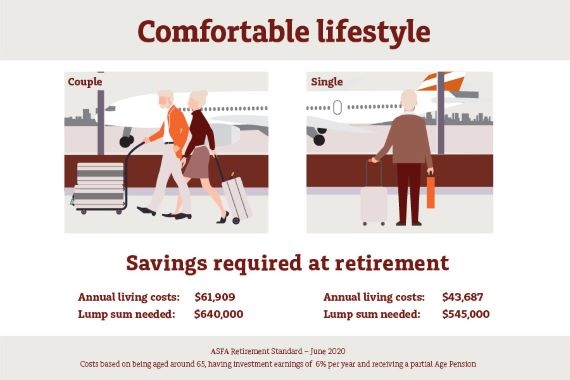While many of us dream about the day we finally get to give up work and reap the benefits of our blood, sweat and tears, we often struggle to plan for it.
After all, in the scuffle of immediate priorities, saving and planning for retirement don’t always make it to the top of the pile.
But there’s a good chance you could be spending almost as long in retirement as you will be working. So, if you really want to end up with the retirement you envision, there are some things you can start doing right now.

1. Determine how much you’ll need
Determining how much annual income you’ll need to maintain your lifestyle in retirement is key and will depend on the type of lifestyle you want in retirement. For example, the types of holidays and frequency, where you’d like to live and your recreational activities.
Once you’ve estimated what your annual retirement income might be, you can start thinking about where you’ll be able to access it from such as your super, part-time work, or social security entitlements. You’ll also be able to determine your total amount of savings needed to meet your desired lifestyle.
A comfortable retirement
If you’re after a comfortable retirement lifestyle which includes a good standard of living and recreational activities such as some overseas travel, The Association of Superannuation Funds of Australia (ASFA) recommends that couples would need an annual income of around $61,909, while for singles this would be approximately $43,687.
Based on you owning your own home, having investment earnings of 6% per year and receiving a partial Age Pension, they estimate that the additional lump sum savings you’d need at retirement to supplement your income and achieve this amount of annual retirement income would be around $640,000 for a couple, while singles would need around $545,000.1

A modest retirement
If a simple retirement lifestyle—that’s slightly better than being on the Age Pension—is more on the cards, ASFA estimate you would need a much smaller lump sum at retirement. However, the amount you’ll need depends on your investment returns and the amount of Age Pension that you’re entitled to.
Based on your circumstances, you’ll need to determine what Age Pension or other social security benefits you might be entitled to in the future and ensure that your other sources or retirement income will be adequate to fund your desired lifestyle.
Rising cost of living
Keep in mind that while you’re likely to have fewer expenses in retirement—you won’t be contributing to your super, you might pay less tax and may have paid off your mortgage—inflation can eat away at your retirement savings.
For instance, if you choose to invest conservatively by having your portfolio solely focused on defensive assets like cash and bonds, your returns may not be enough to offset the rising cost of living.
2. Determine how long it will need to last
Once you have an idea of what your retirement lifestyle will cost, the challenge is to ensure your cash lasts the distance—however long that may be.
While no one can predict how long they’ll live, if we use the average life expectancy of 84.9 for males and 87.6 for females2, you can estimate spending around 20 years in retirement assuming you retire around 65.
3. Are you on track to reach the lifestyle you want?
The next step is to evaluate how much you’re likely to have by the time you retire, if you continue with your current savings strategy.
And this will come down to a variety of factors including:
-
Whether you own your home
-
Value of your super and other investments
-
Return you earn on those investments and income from other sources
-
Your spending habits.
To understand where you currently stand, you need to add up any savings/assets you hold inside and outside of super minus your debts. Then factor in your future earnings and what you can save from those earnings. There are retirement calculators available to help with this.
4. Not on track?
If you find that you may fall short in achieving your desired lifestyle on your projected savings, don’t panic. There are things you can do to turn your situation around.
Make additional super contributions
You can add more into your super on a regular basis using your before or after-tax income. Contribution caps are limit to the amount you’re able to contribute each year without paying additional tax.
If you make a personal contribution, you may be eligible to claim a tax deduction too. This means you’ll reduce your taxable income for the financial year and potentially pay less tax, while adding to your super balance. It’s a win-win!
Delay retiring or work part-time
If you’re flexible with your retirement date, one alternative is to consider delaying your retirement by continuing to work, or working part-time instead of retiring completely. Holding off your retirement, even for a few years, could significantly increase your retirement nest egg. And transitioning to by working part-time can help you prepare – financially, socially and emotionally – for what is a major change in your life. Even if you’re continuing to work part-time, you might still be eligible to receive a social security payment or benefit – such as a partial Age Pension to help supplement your reduced income.
Reduce your debt
Having no debt, or very manageable debt, will reduce your money worries in retirement. You may want to consider a plan to proactively clear your debt by reducing the amount you owe, thereby strengthening your financial position when you retire. However, it doesn’t always have to be all or nothing in terms of diverting your available funds to reducing debt or contributing to super for your retirement.
Speaking to a financial adviser can help determine the best way forward, to manage your debt leading into retirement, while also making sure your retirement goals are on track.
5. Seek professional support
Obtaining independent advice from a financial adviser can help you design a financial plan to achieve your retirement lifestyle goals—whatever they are.
Advisers can also guide you in deciding which investment options may help maximise your retirement income. Most importantly, they can help you plan for a retirement that suits you – whatever that looks like.
Please contact us on 03 6165 2666 if you seek further assistance on this topic.
1 ASFA Retirement Standard – June 2020 https://www.superannuation.asn.au/resources/retirement-standard
2 SuperGuide: How long you can expect to live and what it means for your super – January 2020 https://www.superguide.com.au/retirement-planning/life-expectancy
Source : MLC Insights September 2020
National Australia Bank Limited. ABN 12 004 044 937 AFSL and Australian Credit Licence 230686. MLC Limited uses the MLC brand under licence. MLC Limited is a part of the Nippon Life Insurance Group and not part of the NAB Group of Companies. The information contained in this article is intended to be of a general nature only. Any advice contained in this article has been prepared without taking into account your objectives, financial situation or needs. Before acting on any advice on this website, NAB recommends that you consider whether it is appropriate for your circumstances.
Important: Any information provided by the author detailed above is separate and external to our business and our Licensee. Neither our business nor our Licensee takes any responsibility for any action or any service provided by the author. Any links have been provided with permission for information purposes only and will take you to external websites, which are not connected to our company in any way. Note: Our company does not endorse and is not responsible for the accuracy of the contents/information contained within the linked site(s) accessible from this page.


